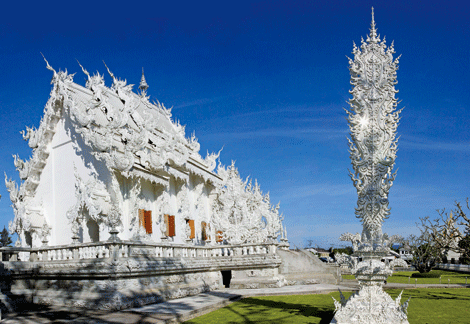Chiang Rai, in the northernmost region of Thailand, is synonymous with the Golden Triangle. While its historic association with the opium trade cannot be erased, this 750-year-old city has fresh new experiences to offer.
First stop from the airport is the Phra Thanamak Doi Tung, once a palace for HRH Princess Srinagarindra, the Princess Mother. The Doi Tung Royal Villa, a structure combining Lanna architecture with a hint of Swiss chalet, is perched on a hill overlooking neighbouring Myanmar and surrounded by lush gardens and greenhouses with blooming petunias, begonias, roses, other temperate flowers and cacti.
A guided tour around the villa fills us in on the life of the Princess Mother, who passed away in 1995. She is revered in Chiang Rai for her efforts in persuading the local tribes to plant vegetable crops, coffee, macadamia nuts, flowering plants and herbs as an alternative to cultivating opium – a personal project that became the beautiful legacy that is the Mae Fah Luang Foundation.
We head west to the mountains of the Chiang Khong to soak up the rich hill tribe cultures of the Hmong and Lahu tribes. A lovely local experience can be had staying at Lanjia Lodge, an eco-friendly, community-based lodge where the villagers charm visitors with their warm hospitality, cuisine and culture. (Rates start at THB2,550/US$81 per night, inclusive of meals.)
We try our hand in the tribal art of making a Hmong batik handkerchief. Using wax and natural violet dye, an older Hmong woman gently guides us through the process. In the evening children and their parents perform dances ornately dressed in traditional Lahu and Hmong garb. The next day, we head to the village shaman’s house to learn how he cures illnesses. In this village thriving on its produce of corn, embroidery and crafts, I get a glimpse of a simple life steeped in deep tribal culture.
Unknown to many, Chiang Rai produces fine tea. We negotiate dizzying zigzag roads to reach the hills of Mae Salong. The reward is picturesque rows of tea plantations at 1,350 metres above sea level. There is a crisp, fresh scent in the air. Soldiers of the 93rd regiment of the Kuomintang Nationalist army settled here after the 1949 Chinese revolution, along with their families – you hear Chinese spoken here more than Thai, and pagodas and Chinese restaurants make it feel more like Yunnan than Thailand.
The tea workers, all women, gently nip off the young tea leaves into large baskets on their backs, dry them in the sun, and then pass them on to be processed in factories. One of the varieties you can sample here is Emerald Thai Tea, a naturally sweet oolong.
With a few hours to spare, we head back to Chiang Rai city to see two unusual temples. Wat Rong Khun, or White Temple, was built only recently by the Thai Buddhist artist Chalermchai Kositpipat, and is entirely glazed in gleaming white paint and glittering pieces of mirror. It is a surreal and stunning sight, combining Buddhist and Hindu elements. Several kilometres away is the Black House, a gallery by Thai National Artist Thawan Duchanee with 25 Lanna-style black buildings filled with antlers, elephant bones and gigantic baskets. Neither temple is a place to pray – rather they are there simply to appreciate life and art. From macadamia nuts, to sweet tea, to unusual temples, Chiang Rai can charm and surprise the most seasoned traveller.

Getting there
There are many direct daily flights from Bangkok to Chiang Rai with Thai Airways, Air Asia, Orient Thai Airways and Nok Air. Alternatively, you can travel via a four-hour bus, car or train ride from Chiang Mai.










